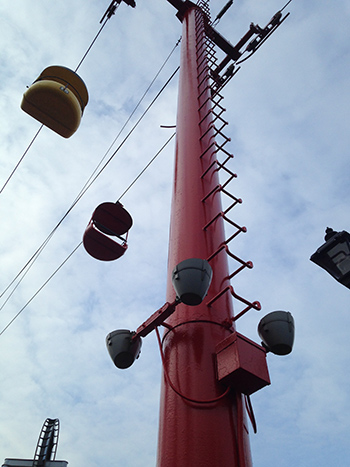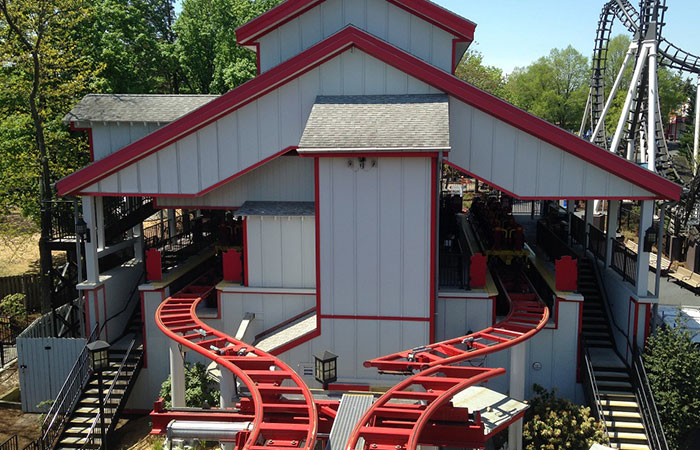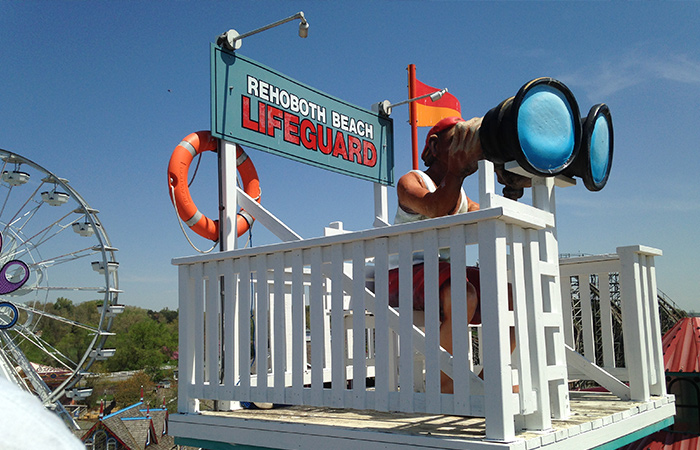When you think of amusement parks, you may think of a variety of images: roller coasters, Ferris wheels, popcorn, cotton candy, long lines, hot summers, the list probably goes on. But for a coatings contractor, that list may expand to the many, many different substrates with different kinds of coatings.
That is now true for Jeff Neal, the project manager at PennCoat, Inc., a Landisville, Pa.-based coatings contractor.
It started with a cold call. Neal was looking for new clients and was calling local businesses that might be in need of coatings services. He called one of the largest amusement parks in the United States, which wishes to remain unnamed, and Neal was thrilled to land the job.
In fact, he was familiar with the location. “I have been before; it’s a fun place to go,” Neal said. “It’s one of the better amusement parks in the country.” With new coatings, Neal and his crew just might help it be even better!
On
a Ride
The job started in March
2015. When Neal and his crew of four arrived on site, they saw what they would
be in for. The entire park was more than 100 acres (404,685.6 m²), and the team
would be working on rides throughout the park.
“That
was one of the biggest issues because what we didn’t account for in the initial
bid was how much time it would take to go from one ride to another to another,”
Neal said. “Usually when we’re working everything is in walking distance from
one another.” But if you think of your own visits to amusement parks and how
much time it takes to get from ride to ride, you will understand how that could
be a problem.
“Three,
four guys walking, carrying all this equipment and paint can become taxing,”
Neal said. “We had our company vans inside the park, so that made it a lot
better.” The vans decreased the travel time from 20 to 5 minutes, which saved a
lot of lost time from the budget.

But
distance was not the only big thing about this job. Neal and his crew were not
just coating one ride or one substrate. They were applying coating to several
different rides, which meant different substrates, different coatings, and
different procedures for each ride.
One
of the jobs was the waiting deck for one of the roller coasters, which is the
overhang that the line of riders winds underneath to stay out of the sun. The
job also involved the hand railings that keep the line orderly. The deck was
made out of 1,500 square feet (139.4 m²) of T1-11 siding and wood trim. Neal’s
crew assessed the job and got to work.
“Because
it was a wood substrate, we gently rinsed it with a pressure washer,” Neal
said. “We didn’t want to go too strong to prevent splintering.” Then they put
down two coats of light gray Sherwin-Williams Duration for a total average thickness
of 8 mils (203.2 microns). They rolled the coating onto the siding. “It’s really
absorbent, so we would really have to roll it on and work it into the
material,” Neal said. “Otherwise you’ll get picture framing where some of the
substrate is more absorbent than others, so it would soak in more and look like
an uneven finish.”
All of this extra coating meant the job was
“eating up more materials than anticipated,” Neal said. “We kept rolling on
more until we had a nice even finish.”
For
the trim work, they put down a safety red Sherwin-Williams Sher-Cryl coating in
two coats for a total average thickness of eight mils (203.2 microns). They covered
700 feet (213.4 m) of trim.

“The
trim was more time consuming because it was more detailed work,” Neal said. “We
did that work with a brush, and we would have to cut it in and make sure we
don’t get any on the T1-11. That was more finesse, so it required couple more
hours to complete.”
The
total roller coaster deck job took about nine hours. Because the building was
about 30-feet (9.1 m) tall, the crew used a boom lift to reach the top.
Then
they moved on to a railroad track that was 110-feet (33.5 m) long. The crew had
to coat the safety rails and hand rails, which were made of metal.
“It
was difficult to get access because the part of track with safety rails was in
an area that was on the side of a hill,” Neal said. For that section of the
job, the crew wore harnesses and tied off to those safety rails.
To
recoat them, first they pressure washed the substrate using a turbo tip
pressure washer and took a hand tool wire wheel to “any place that looked like
it had excessive rust,” Neal said. “Once it was prepped we painted it.”
They used Carboline Carboguard 690 as a primer
and put down one coat in approximately two mils (50.8 microns), then they topped
that off with two coats of Carboline
Carboguard
134 HG for an average total
thickness of eight mils (203.2 microns).
Waterpark
Nightmare
Just when Neal and his
crew were getting the hang of being inside the park, they saw their next task.
It was a giant funhouse waterpark, but it looked anything but fun for a
coatings applicator.
 “It
was made of fiberglass and had wood in it, steel in it. There were so many
different substrates and colors involved, there was no efficient way to
estimate how many hours we would need to complete the entire project,” Neal said.
“It involved a lot of close discussion with the maintenance manager on site —
what he wanted us to focus on and what we could turn the other way on.”
“It
was made of fiberglass and had wood in it, steel in it. There were so many
different substrates and colors involved, there was no efficient way to
estimate how many hours we would need to complete the entire project,” Neal said.
“It involved a lot of close discussion with the maintenance manager on site —
what he wanted us to focus on and what we could turn the other way on.”
The
manager understood Neal’s pain. “He referred to the funhouse as a maintenance
nightmare because all the water going through it caused peeling paint,” Neal
said.
The
owner provided all the paint for that job, which involved about 50 different
colors and products to use. “It was really challenging to know what his
expectations were,” Neal said. “We walked through it and excluded all of the
fiberglass. There was a lot of wood paneling on there that needed coating and
corrugated steel decking that was starting to show rust.”
The crew used a hand tool on the steel decking,
then put down orange and blue Sherwin-Williams Corothane in two coats for a
total approximate thickness of eight mils (203.2 microns).
Fun
House
Five weeks later all of
the work was done, and, despite the challenges, Neal was glad he took the job. “It
was really neat to get behind the scenes,” he said. “And it was fun to be able
to say you were working at the amusement park.”
Neal
said his crew did such a great job working with the client that they’re now
pricing out projects for next year as well. That means more time spent at the
amusement park.